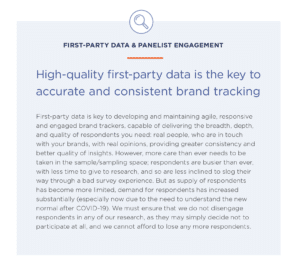
By: Nancy Brigham, Ph.D. – VP & Head of Research Science, Dynata
The Rise of the Empowered Consumer and the Increasing Need for Brand Tracking
The number of brands, products, and services available to consumers today is staggering. This explosion has been helped along by forces such as increased competitive action (e.g., brand proliferation and extension), the increase in online marketplaces with global deliverability (e.g., Amazon, eBay, Alibaba), and the continuing segmentation of the consumer mass market.
Today’s consumer also has ready online access to brand/product information, cost/attribute comparisons, and feedback on a 24/7 basis, whether from the brand itself, family and friends on social media, influencers, or other sources. Mobile devices allow this information access to happen anywhere – often in front of the products on a store shelf.
This results in an empowered consumer who has more choice, more information to inform their choice, and a greater ability to select the brands, products, and services that fit their lifestyle, values, and budget. In turn, this increased consumer empowerment influences and changes brand decisions and strategies over the longer term.
The Challenge of Brand Tracking
In this complex, constantly evolving landscape, the need to consistently (and continuously) measure and track your brand’s health and performance, in real time, is critical. Brand tracking allows you to understand your brand over time – how your consumers think, feel, buy, and use it, performance trends in market, how you are positioned relative to competitors, etc. This information, in turn, helps you manage and grow your brand, for example: assessing which initiatives work well and increase sales; uncovering new opportunities; testing different strategies; understanding growth potential; and improving your product in line with consumer needs.
While the need for real-time tracking is clear, it is also made more challenging by this complex environment. Businesses are facing tighter marketing and research budgets (which the COVID-19 pandemic made worse) and are looking for creative ways to maximize insights on reduced budgets. And, as brand engagements now happen through many touchpoints and channels, empowered consumers are also forcing businesses to reassess both how they address consumer needs and engage with consumers.
What is Agility & Why it Matters
In this challenging environment, brands need to stay in touch with their consumers using more agile and engaged approaches. Use of more agile approaches help capture the entire consumer/brand landscape, at the right time, as well as fully understand the connections between consumer intention and actions in the marketplace.
Emphasis should be placed on real-time capabilities that accelerate insight generation so that timely data can be prioritized in the decision-making process, prioritizing tools/approaches that allow you to continuously collect qualitative and quantitative data from your consumers, enabling constant brand health tracking and measurement – and using this data to develop insight that allows you to rapidly respond and adapt your marketing and brand strategies accordingly.
Brand tracking also needs to adapt to this new normal, maintaining consistency while recognizing that the days of keeping the same sampling requirements for years with little change are over. Trackers must evolve to reflect the current respondent environment, or the data and insights that come out of them will be misleading. Indeed, consistency (such as with sample blends) is challenging (if not impossible) to maintain over time when a tracker cannot incorporate respondent/marketplace changes.
Just as brands review and incorporate new business insight needs into their trackers, tracker methodology/design elements should be flexible and adaptable as well. We recommend a yearly review of all tracker design elements (e.g., blend, sampling, weighting, quotas, questionnaire), with the objectives of 1) addressing any issues while they are still small enough not to impact your data, and 2) ‘future-proofing’ the tracker by making bigger changes over several years. Smaller tweaks/changes over time can allow consistency to be maintained within acceptable limits, while allowing the tracker to evolve along with the respondents and reflect true marketplace conditions.
With agile, real-time brand tracking, using first-party data (engaged, “real” people), and including yearly adaptation of your methodology/design as needed – you will be well-positioned to spot trends and behaviors, enabling optimal brand decision-making and driving brand growth!

Author Bio
As an expert in research method and strategy, and application of those to business solutions, Dr. Nancy Brigham has worked across both the client and supplier sides of marketing research. She joined Dynata’s Research Science team in June 2021, playing a leading role in furthering Dynata’s leadership position in the first-party data space through research-on-research, sampling methodology/best practices, client engagement, and industry thought leadership. Prior to joining Dynata, she spent 10 years at Ipsos as SVP, Head of Global Sampling & RoR in their online operations division; and spent 12 years at Procter & Gamble in marketing research. Nancy is a regular speaker and publisher, and recently served a three-year term on the Board of Directors of SampleCon. She holds a Ph.D. and Masters in Experimental Social Psychology from the University of Kentucky, and a B.A. in Psychology and Advertising from the Ohio State University.

